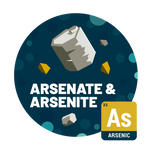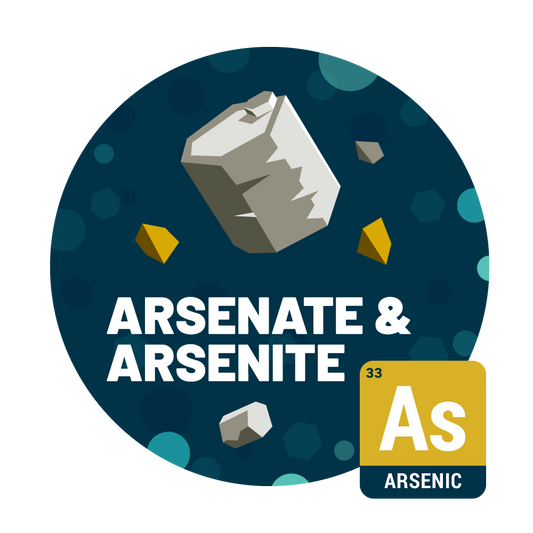
Arsenic in Drinking Water: Everything You Need to Know
Our blog is written by real experts— not AI. Each guide is carefully reviewed and updated based on the latest research. Plus, with no affiliate links, you can count on unbiased insights you can trust.
Arsenic, like lead, has a long and complicated history. Despite attempts to regulate it and reduce peoples’ exposure to it, arsenic still turns up regularly in drinking water sources nationwide. Due to its toxicity, this can be a cause for alarm.
In this ultimate guide to arsenic, we break down the different forms of arsenic, their sources and exposure potential, and how to test and treat your drinking water to help keep you and your family safe.
Table of Contents:
- What is Arsenic?
- How Does Arsenic Contaminate Drinking Water Sources?
- Health Impacts of Arsenic Exposure
- Safe Levels of Arsenic in Drinking Water
- Recognizing Arsenic in Drinking Water
- Testing Water for Arsenic
- Treating Arsenic
- What's the Takeaway?
What Is Arsenic?
Arsenic (As) is a naturally occurring metalloid, a toxic element found in the Earth’s crust that can be present in rocks, soil, air, and groundwater. The most common source of arsenic exposure is contaminated groundwater. It typically enters the water supply through the natural weathering of rocks.
Past and current uses include pharmaceuticals, wood preserving, agricultural chemicals, and activities like mining, the creation of alloys, and the processing of glass, textiles, and ammunition.
Two Forms of Arsenic
Arsenic can exist in two forms:
- Organic
- Inorganic
Organic arsenic molecules are attached to complicated carbon structures and are considered non-toxic, or considerably less toxic than their inorganic counterparts.[1]
Inorganic arsenic molecules are arsenic compounds without carbon molecules. Unlike organic arsenic, inorganic arsenic is considered highly toxic to humans and unfit for consumption. Inorganic arsenic is found in soil, sediment, and groundwater. It occurs either naturally through the weathering of minerals and ores or as a result of commercial mining, ore smelting, or other industrial activity.[2]
How Does Arsenic Contaminate Drinking Water Sources?
By and large, arsenic contaminates groundwater sources (aquifers and wells) because it occurs naturally in the earth’s crust. Surface water sources (lakes and rivers) are somewhat less commonly impacted, although arsenic contamination of surface water supplies does result from the natural weathering of rocks and the flow of sediment.[3]
On a smaller—but no less significant—scale, human activities such as mining operations, burning of fossil fuels, and arsenical agricultural activities are responsible for arsenic contamination of drinking water supplies. Burning of coal, for example, has a pronounced effect on arsenic contamination as emissions from these activities ultimately reach water reservoirs.
What Are the Health Effects of Arsenic Exposure?
Arsenic has toxic health effects after acute and chronic exposures, and people are typically exposed by ingesting contaminated food or drinking water. While amounts found in drinking water are normally quite low, chronic exposure leads to lasting negative impacts. Arsenic is a known human carcinogen and impacts many different body systems, detailed below.[7]
Dermal (or skin) absorption is minor and would be unlikely to present an issue at concentrations present in drinking water.

Acute Arsenic Exposure Symptoms Include:
- Abdominal pain
- Vomiting
- Muscle aches
- Flushing of skin
- Numbness and tingling of extremities
- Progressive deterioration in motor and sensory responses
- Death
Chronic Arsenic Exposure May Lead To:
- Skin lesions
- Blood system impacts
- Diabetes mellitus
- Impacts to the eyes
- Cardiovascular impacts
- Respiratory system impacts
- Gastrointestinal impacts
- Immune system impacts
- Nervous system impairment
- Impacts to liver and kidneys
- Developmental effects
- Increased risk of cancer
What Level of Arsenic is Safe in Drinking Water?
The Environmental Protection Agency (EPA) enforces an MCL (Maximum Contaminant Level) for arsenic of no more than 10 PPB, but this regulation is not purely health-based—it balances health risks with the financial burden on utilities to implement treatment tech.[3]
The MCLG (Maximum Contaminant Level Goal) is purely health-based and recommends a concentration of 0 PPB, meaning that the EPA has concluded there is no safe level of arsenic in drinking water for long-term consumption.
Because arsenic is detrimental to children’s health and development, it’s important to be vigilant about arsenic levels if you are a parent or expectant parent.
Water Testing for New and Expectant Parents
How Do You Know if Arsenic Is in Your Drinking Water?
Arsenic has no discernible taste, smell, or color. Levels can vary between wells, even within a relatively small area, and there is no way to know how much arsenic will affect a well before it is drilled. The only way to determine the level of arsenic contamination in your drinking water is to have your water tested.
Utility companies mail out consumer confidence reports (CCRs) that include arsenic levels in water supplies. Those on smaller water systems and private wells should consider testing their water with a certified laboratory, preferably twice a year, to understand their arsenic levels.
How Common is Arsenic Contamination of Drinking Water?
A U.S. Geological Survey study from 2017 found that some 2.1 million Americans source their drinking water from private wells with high concentrations of arsenic.[8]
Arsenic contamination is spread throughout the continental United States, with high levels turning up in wells across the west, parts of the northeast and midwest, and some of the southeastern coastal states.
It’s important to note that approximately 44 million Americans use private wells and routine testing of wells does not usually include assessing arsenic levels.
Does My Water Source Make a Difference?
-
Private Well Owners
Arsenic III is more common in well systems, specifically in reduced or low oxygen waters, though it is common for both forms of arsenic to be present.
Additionally, there is a general trend between pH and arsenic concentration in groundwater. As the pH increases, arsenic concentration tends to increase as well. So if you know the pH of your well water is high, your water could have higher concentrations of arsenic.[11]
If testing your well water has shown higher than acceptable arsenic concentrations, we recommend testing your well regularly—twice a year—as well as any time you notice iron concentrations in your water fluctuating (see below).
-
Public Water Systems
Arsenic V is more common in public water systems. Public water systems treat water with chlorine and chlorine acts as an oxidizer that converts As III into As V.
How Do I Test My Well Water in a Lab?
Arsenic and Plumbing Systems
Arsenic has been shown to attach to iron particles in pipes. Because iron is very effective at binding with arsenic, pipes with corrosion deposits are very likely to have high concentrations of arsenic if the source water already contains arsenic.[14]
Although arsenic is measured for compliance purposes at the entry point of public water systems, concentrations can increase throughout the pipe network in the form of arsenic-rich scale. This scale can impact arsenic levels in your drinking water two ways:
-
Increases in flow: Certain conditions, like flushing or fire flow conditions can increase the flow of water through pipe networks and dislodge arsenic-rich scales that end up as a part of the water that flows from your tap.
- Water chemistry: Changes in water chemistry as a result of using new source waters, blending different source waters, or industrial or natural disasters can cause arsenic buildup in pipes to dissolve back into the water that flows through the network to your tap.
How Do I Test My Water for Arsenic?
The best way to test your water for arsenic is through a certified laboratory. There are two common types of arsenic tests: Total arsenic and arsenic speciation.
When Should I Test for Total Arsenic?
Total arsenic tests are the first step if you are concerned about arsenic in your water supply. Total arsenic is the measure of all of the arsenic present in a sample of water, food, or any other type of substance (organic and inorganic), without differentiating which form of arsenic is present.
Some water testing packages include total arsenic with other heavy metals, contaminants, and water chemistry parameters.
When Should I Consider an Arsenic Speciation Test?
If you know (or learn that) you have concerning levels of arsenic in your water and you want to know how to effectively remove it, you need to determine the oxidation state of the inorganic arsenic in your water—arsenic III or V—and how much of each. Arsenic speciation tests determine the oxidation state of the arsenic in your water.
In drinking water, all arsenic present is typically inorganic arsenic, especially in areas with naturally high levels of inorganic arsenic. Inorganic arsenic can be separated into two primary forms: arsenic III and arsenic V.
Arsenic III
Arsenic III, or arsenite, is the trivalent form of arsenic, with a charge of +3. It is highly toxic and bioreactive.
Arsenic V
Arsenic V, or arsenate, is the pentavalent form of arsenic, with a charge of +5. Arsenic V is not as toxic as arsenic III, but still poses a health risk with long term exposure.
How Are They Different?
Arsenic III and arsenic V are two different oxidation states of arsenic. The oxidation state describes how an atom can gain, lose, or share electrons with other atoms when forming chemical bonds.
The oxidation state is key to understanding how specific arsenic compounds can be removed from water. Arsenic III is more likely to be present in groundwater than in surface water, and is also harder to remove because it is typically part of an uncharged compound at neutral pH.
Arsenic V, on the other hand, is typically part of a compound that carries a charge at neutral pH and is much easier to remove via ion exchange, sorption and other removal processes.[4] This is why testing your water for arsenic in a laboratory setting is crucial.
Once you’ve learned your sample’s arsenic profile, you can then consider treatment options. If you do not do a speciation test, it is best to err on the side of caution and assume your water contains arsenic III (and thus needs to be oxidized as part of the treatment process).
Arsenic Speciation Water Test
Determine the oxidation state of arsenic in your drinking water–arsenic III or arsenic V.
Essential Home Water Test
Basic testing panel for water utility customers or private well owners concerned primarily by metals, bacteria, aging pipes, and infrastructure.
Advanced City Water Test
The best water test kit for common concerns in public utility water, like lead, hardness, and VOCs.
Can I Use Test Strips for Arsenic?
Although a variety of DIY test strips for arsenic are available on the market, their reliability is highly contested and they are not recommended.
Generally, test strips are accurate for only a few specific parameters. They are also highly prone to error. Keeping in mind the health risks posed by consuming arsenic-contaminated water, it is a far safer bet to have your water tested through a certified laboratory.
What Can I Do About Arsenic in My Drinking Water?
Arsenic can be removed from your water supply through a variety of treatment technologies. It is important to test your water for arsenic before treatment because it carries no taste, smell, or color.
If your water sample contains arsenic, we recommend sourcing your water elsewhere or considering a treatment device. Some effective treatment methods for arsenic include:
- Reverse osmosis
- Anion exchange
- Adsorptive media: activated alumina, iron-based filters
- Distillation—not typically recommended
Which Treatment Method Is Right for Me?
The choice of treatment method depends on the oxidation state of arsenic present in your water. If you have a private well that has arsenic and do not want to do a speciation test, it is best to assume your water contains some arsenic III when you are deciding what treatment technology to install. Water provided by public water systems is unlikely to contain arsenic III.
Pretreatment
It is important to pretreat water that contains arsenic III in order to oxidize it to arsenic V. Treatment methods for arsenic are generally more effective in removing arsenic V when compared with arsenic III and some, including anion exchange, will not remove arsenic III at all.
Chlorination is generally the best pretreatment method to convert arsenic III to arsenic V; chloramination, aeration and UV are not effective. [14,15]
The following treatment technologies have been shown to be effective in removing arsenic V from drinking water (look out for NSF/ANSI standards 53 and 58 for arsenic):
Reverse Osmosis (RO)
Testing has shown point-of-use (POU) RO systems to be up to 99% effective at removing arsenic from drinking water.[15] RO systems force water through a selective membrane with microscopic pores to allow water molecules through while trapping larger, inorganic molecules like arsenic.
RO systems are energy intensive and have high operating costs but are effective in removing a wide variety of contaminants in addition to arsenic. NSF/ANSI standard 58 applies to reverse osmosis systems. Be sure the product in question is certified for arsenic.
Anion Exchange
Anion exchange technology uses resin beads that attract oppositely charged particles while water is passing through the filter. The resin must be chosen specifically for arsenic removal.
Anion exchange systems are typically installed at the point-of-entry which results in higher installation and operation costs. High TDS and sulfate can impact treatment efficacy.
Adsorptive Media: Carbon Block, Activated Alumina, and Iron-Based Sorbents
Carbon block, activated alumina and iron-based sorbents work through a process called adsorption, whereby water contaminants—like arsenic—are drawn to and held by the filter media as water flows through the filter bed. Be sure to look for products with a certification seal from a third-party like the WQA, NSF, or IAPMO.
The pH of the water can impact treatment effectiveness for both types of media, more so for activated alumina, and high phosphate concentrations can significantly reduce effectiveness of iron-based sorbents.
Distillation (not typically recommended)
Distillation units boil water, collect the purified vapor, and turn it back into purified water. Contaminants stay in the boiler and the water that results has had all its impurities removed—including beneficial particles like calcium and magnesium.
NOTE: Simply boiling water is not the same as distillation. Distillation removes a wide variety of contaminants and kills pathogens, but energy requirements are high and can get expensive. Distillation units themselves can be expensive and only produce small amounts of water at one time. Effective for both arsenic III and arsenic V.
Do I Need Point-of-Entry (POE) Treatments to Remove Arsenic?
POE, or whole-house, treatments are not necessary unless you intend to drink water from all the faucets in your home—it is typically fine to use water with small amounts of arsenic for other purposes like washing dishes, bathing, brushing teeth, etc. Installing POU devices (e.g. under the kitchen sink) can save you money down the line and still provide water that is safe to use.
Does Boiling Water Remove Arsenic from Drinking Water?
No, boiling water does not remove arsenic from drinking water. Instead, boiling water can actually increase the concentration of arsenic levels in a sample of water.
Do Pitcher Filters like Brita or PUR Remove Arsenic from Drinking Water?
No, most countertop pitcher filters are typically not effective at removing arsenic from your tap.
Tap Score has prepared unbiased pitcher filter reviews for Brita, PUR and Berkey filter systems where you can look specifically for arsenic removal.
Ultimate and Unbiased Guide To The Best Water Filters For Your Home
What’s the Takeaway?
- Arsenic is a naturally occurring, toxic metalloid found in the earth’s crust. Of the two major forms—organic and inorganic—inorganic arsenic poses the most risk to humans. Inorganic arsenic contains two oxidation states: arsenic III (arsenite) and arsenic V (arsenate).
- Arsenic III is the type of inorganic arsenic most commonly found in private wells and is the form most detrimental to human health. Arsenic V is more commonly found in public water systems, and can still pose a health risk over the long term.
- Arsenic speciation tests are recommended for identifying the oxidation state of arsenic in your water—arsenic III or arsenic V. Understanding which type of arsenic is in your water is vital to proper removal.
Read More
▾How Do I Test My Well Water in a Lab?
Ultimate and Unbiased Guide To The Best Water Filters For Your Home
Sources and References
▾- Arsenic Factsheet | National Biomonitoring Program | CDC
- Arsenic Compounds | EPA
- ARSENIC FACT SHEET | WQA
- Technologies for Arsenic Removal from Water: Current Status and Future Perspectives - PMC
- Arsenic Toxicity - StatPearls - NCBI Bookshelf
- Arsenic | National Institute of Environmental Health Services
- What’s in your water? A well-known risk for arsenic toxicity - PMC
- Study Estimates about 2.1 Million People using Wells High in Arsenic | U.S. Geological Survey
- Arsenic and Children | Arsenic and You
- Arsenic Contamination of Groundwater: A Review of Sources, Prevalence, Health Risks, and Strategies for Mitigation - PMC
- How Does Arsenic Get into the Groundwater? - University of Maine
- Reverse Osmosis Filter Use and High Arsenic Levels in Private Well Water - PMC
- This fact sheet helps water system owners and operators understand and respond to issues that may arise with arsenic | EPA
- Arsenic Treatment Technology Evaluation Handbook for Small Systems
- Drinking Water Treatability Database | EPA
- Arsenic in Well Water-Minnesota Dept of Health












